Te Reo Māori in Linux
Posted on Tāi 02 Poutū-te-rangi 2023 in Geekery
I worked for a number of years at Catalyst, one of the things I would often do ahead of Te Wiki o te Reo Māori would be to give a reminder of some of the tweaks that have been done over the years to help the support of Te Reo Māori on our workstations (PCs and laptops).
This page is the first part of an expanded version of the documention I had written for that, and describes how to set up the Māori keyboard and install the Māori dictionary. The next page in this series Te Reo Māori in Linux (Advanced) installs the Māori language pack and configures the locale so that there is more Te Reo Māori in the interface of your workstation.
I should point out that as we go through this, that the correct spelling is Māori with the macron on the 'a' to signify the longer vowel sound. You may notice that Maori (without the macron) has been used where it appears as that in the dialogs and windows.
Māori Keyboard
In Te Reo Māori, the tohutō (macron) is used to indicate a longer vowel sound. It isn't really a smart thing to take the short cut of skipping the macron on the vowel as it can change the meaning. Some iwi eg Waikato-Tainui1 will use a double vowel (aa) rather than the macron (ā).
"I was outside enjoying the night, but there was weta2 all around me" is very different to "I was outside enjoying the night, but there were wētā3 all around me"
The Māori keyboard has been installed as the default keyboard layout on the Catalyst PCs and laptops for many years. In Linux, the RightAlt is used as the 'Compose' key to allow you to type a vowel with the tohutō eg ..
<RightAlt><a>= ā<RightAlt><Shift><e>= Ē
There are other ways to get the macron, but this has seemed to be the easiest for most people. Worth noting that in a Windows environment, they have chosen to use the backtick ` as the compose key to get the macron.
At Install Time
It does make it a lot easier to configure a Linux machine with the Māori keyboard as part of the initial installation, it deals to the GUI4 and console in one easy step.
When you get to the Keyboard Layout, change the default English (US) by scrolling down and selecting Maori before pressing Continue.
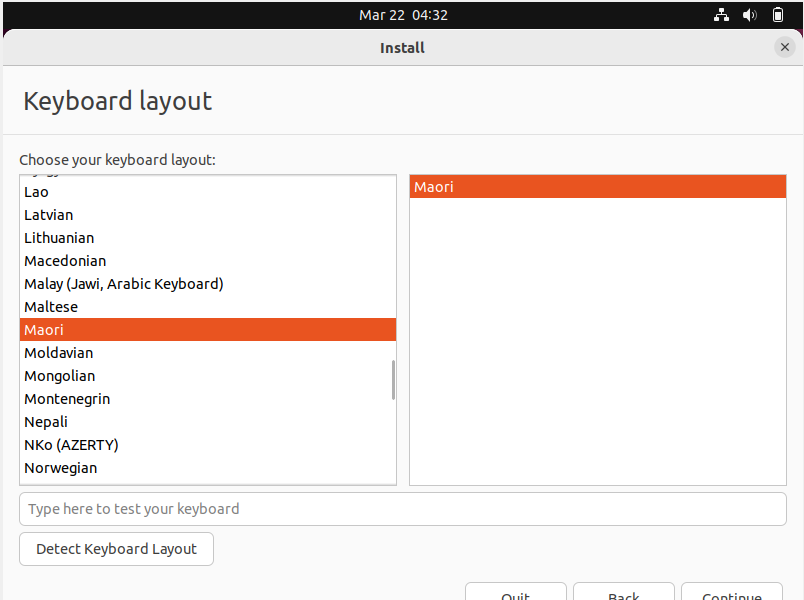
This method does also make it easier to use macrons in the user's name or passphrase as you continue the install process.
GUI
If you haven't had the Māori keyboard installed as part of the original installation, you can still install it. Some people may be happy to just have the Māori keyboard installed to be used in their GUI applications.
Although I describe how to remove the English (US) keyboard, it is not necessary.
Just tell me how
For the quick "just tell me how to do it" instructions ..
Settings -> Keyboard -> Input Sources -> + -> ⋮ -> Other -> Maori -> Add -> English (US) -> ⋮ -> Remove
With pictures
And for a bit more descriptive version. Start the Settings application and move down to Keyboard, you should see something like this
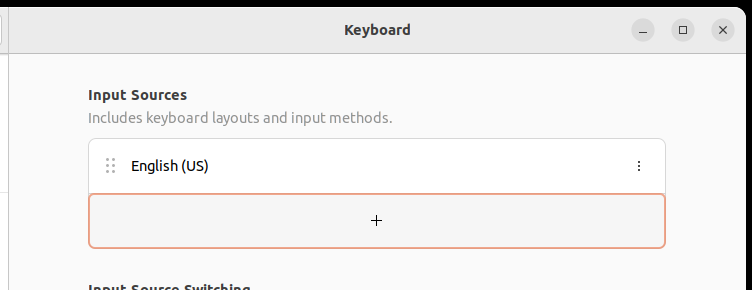
Click on the + and then then ⋮ and then Other (there is probably something they can do to make that easier). Scroll down to Maori (or use the search). Click on Maori and then Add.
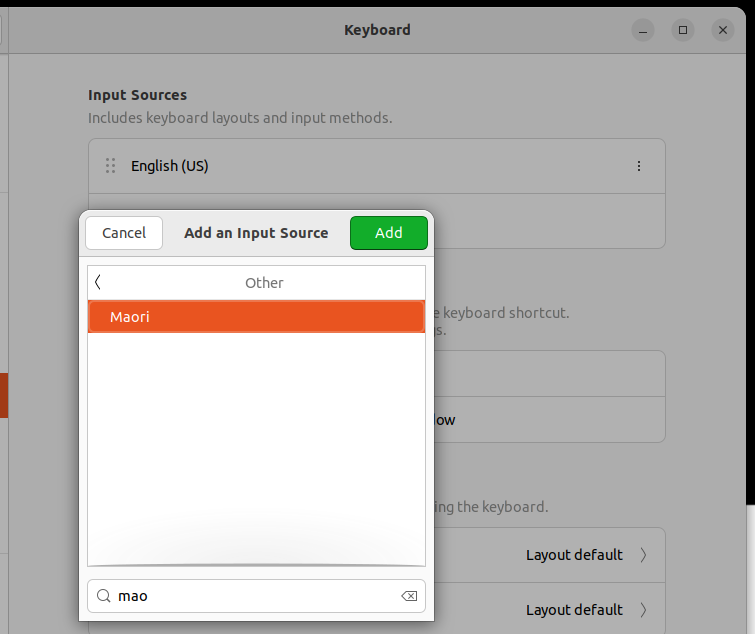
In the following image I have already swapped the Maori and English (US). Clicking on the ⋮ to the right of the keyboard layout you get the options to move it up or down and to remove it. I remove the English (US) keyboard because it doesn't actually give me anything the Māori keyboard doesn't.
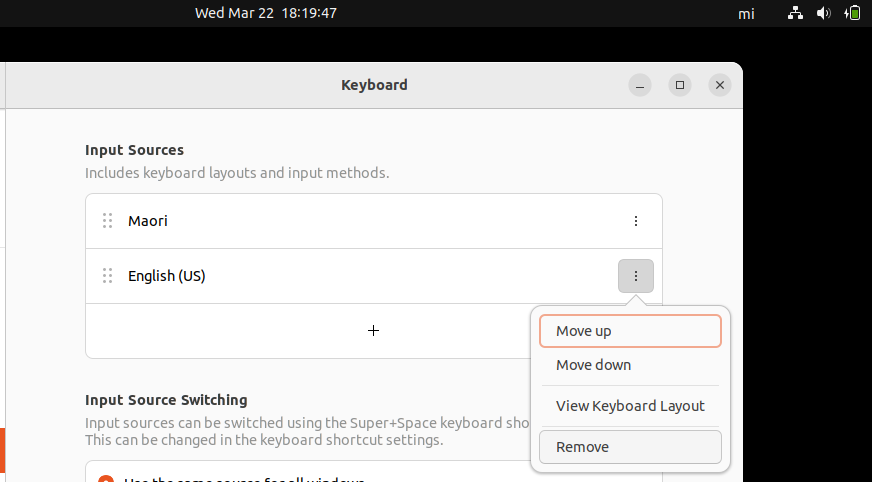
You can see in the top right the 'mi' to show the Māori keyboard is active while I have the English (US) still installed. If you have other keyboards installed you can click that to swap, no need to restart anything (and it won't remove the macrons you have already used).
Console
We do want to be able to type tohutō directly in the console rather than having to always do things via a GUI terminal. Sometimes the GUI just doesn't work or you are on a server without a GUI.

To do this we need to set XKBLAYOUT="mao" in the file /etc/default/keyboard
For most people using gedit will be easier than using vi to do the editing ..
sudo gedit /etc/default/keyboard
Change 'us' to 'mao', save the file and close the window. The macrons will be available at the console after a restart.
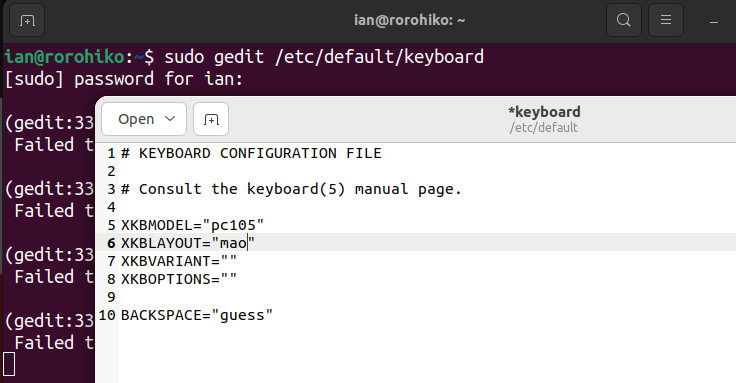
You may notice some 'Failed' messages running the sudo gedit command, you can safely ignore those.
Māori Dictionary
To help with the spell checking of some Te Reo Māori, you can install an Ubuntu (& Debian) package 'myspell-mi-nz'. This provides a dictionary that most applications can pick up to help the spell check, although generally you only seem to be able to use one language at a time.
Unfortunately this package is not in an official repostitory, but here are some instructions on how to install that package.
First, from a terminal5, we create a directory to download the package to ..
mkdir -p ~/install_māori
cd ~/install_māori
We then download that file we need ..
wget http://ubuntu.catalyst.net.nz/pub/catalyst/debian/dists/stable/catalyst/binary-all/myspell-mi-nz_20160923-1_all.deb
And install the package ..
sudo apt install ./myspell*.deb
There is likely to be an error about user _apt not having permission, you can safely ignore that.
You should now be able to change the language of the spell checker in an application to provide some help checking your Te Reo Māori. The current version of the dictionary is based on version 3.01 of the Te Ngutu Kura Māori word list. Copyright 2011 Karaitiana Taiuru. Unfortunately this is no longer being maintained and needs a new Kaitiaki.
Next Steps
If you now want to go through and change the interface of your Ubuntu worsktation so that you see more Te Reo Māori, head to the next page in this series Te Reo Māori in Linux (Advanced)
-
https://www.countiesmanukau.health.nz/about-us/use-of-the-double-vowel-in-te-reo-maaori-at-cm-health/ ↩
-
Graphical User Interface ↩
-
Some less technical ex-colleagues will know the terminal as the 'black window you make us type things in'. Easiest way to get to it is by pressing the key combination
<Ctrl><Alt><t>. ↩